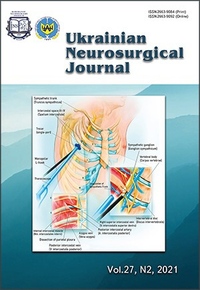Cranial nerve function after cerebellopontine angle meningiomas removal
DOI:
https://doi.org/10.25305/unj.226745Keywords:
cerebellopontine angle, auditory nerve, facial nerve, meningiomaAbstract
Objective. To analyze cranial nerves (CN) dysfunction incidence in cerebellopontine angle (CPA) meningiomas removal depending on topographic and anatomical tumor location type and define the ways to reduce CN dysfunction incidence and severity.
Materials and methods. The study included 30 CPA meningioma patients operated on in the clinic over a 10-year period (from 2010 to 2020 inclusive). Tumor characteristics, the degree of extent (including matrix location, particularly in relation to the internal auditory canal (IAC), jugular foramen (JF), and Meckel’s cave), and supratentorial extension were assessed. The tumors were divided into 5 groups according to the classification of Nakamura et al. Particular attention was paid to the presence and severity of pre- and postoperative cranial nerves dysfunction.
Results. Different groups of CPA meningiomas in terms of the presence of a new CN neurological deficit were compared in the study. CN VII dysfunction was more frequently detected in group 2 — meningiomas extending to IAC, which was 54.5% of all observed tumors in this group vs. premeatal tumors, where new CN VII deficit was 20%, in group 1. At the same time in groups 3, 4, and 5 there was no new CN VII deficit.
Conclusions. The most frequent symptoms in patients of all groups were dizziness, headache and unsteady gait. Of all the symptoms, only unsteady gait and hearing impairment were more common in patients in group 2, however the differences were statistically insignificant (p = 0.135 and p = 0.268, respectively). Trigeminal nerve and auditory nerve were most commonly affected. Auditory nerve lesions were more often detected in patients of group 2 than in patients of other groups, however, the differences were statistically insignificant (p = 0.268). In general, there were no statistically significant differences between the groups in terms of the incidence of various symptoms and the incidence of CPA cranial nerve damage.
References
1. Ostrom QT, Patil N, Cioffi G, Waite K, Kruchko C, Barnholtz-Sloan JS. CBTRUS Statistical Report: Primary Brain and Other Central Nervous System Tumors Diagnosed in the United States in 2013-2017. Neuro Oncol. 2020 Oct 30;22(12 Suppl 2):iv1-iv96. [CrossRef] [PubMed] [PubMed Central]
2. Bassiouni H, Hunold A, Asgari S, Stolke D. Meningiomas of the posterior petrous bone: functional outcome after microsurgery. J Neurosurg. 2004 Jun;100(6):1014-24. [CrossRef] [PubMed]
3. Agarwal V, Babu R, Grier J, Adogwa O, Back A, Friedman AH, Fukushima T, Adamson C. Cerebellopontine angle meningiomas: postoperative outcomes in a modern cohort. Neurosurg Focus. 2013 Dec;35(6):E10. [CrossRef] [PubMed]
4. Kane AJ, Sughrue ME, Rutkowski MJ, Berger MS, McDermott MW, Parsa AT. Clinical and surgical considerations for cerebellopontine angle meningiomas. J Clin Neurosci. 2011 Jun;18(6):755-9. [CrossRef] [PubMed]
5. He X, Liu W, Wang Y, Zhang J, Liang B, Huang JH. Surgical Management and Outcome Experience of 53 Cerebellopontine Angle Meningiomas. Cureus. 2017 Aug 3;9(8):e1538. [CrossRef] [PubMed] [PubMed Central]
6. D'Amico RS, Banu MA, Petridis P, Bercow AS, Malone H, Praver M, Wang TJC, Isaacson SR, Sisti MB. Efficacy and outcomes of facial nerve-sparing treatment approach to cerebellopontine angle meningiomas. J Neurosurg. 2017 Dec;127(6):1231-1241. [CrossRef] [PubMed]
7. Hassaan SA, Tamura R, Morimoto Y, Kosugi K, Mahmoud M, Abokerasha A, Moussa A, Toda M, Yoshida K. Surgical outcomes of anterior cerebellopontine angle meningiomas using the anterior transpetrosal approach compared with the lateral suboccipital approach. Acta Neurochir (Wien). 2020 Jun;162(6):1243-1248. [CrossRef] [PubMed]
8. Sanai N, McDermott MW. A modified far-lateral approach for large or giant meningiomas of the posterior fossa. J Neurosurg. 2010 May;112(5):907-12. [CrossRef] [PubMed]
9. NakNakamura M, Roser F, Dormiani M, Matthies C, Vorkapic P, Samii M. Facial and cochlear nerve function after surgery of cerebellopontine angle meningiomas. Neurosurgery. 2005 Jul;57(1):77-90; discussion 77-90. [CrossRef] [PubMed]
10. Acioly MA, Liebsch M, Carvalho CH, Gharabaghi A, Tatagiba M. Transcranial electrocortical stimulation to monitor the facial nerve motor function during cerebellopontine angle surgery. Neurosurgery. 2010 Jun;66(6 Suppl Operative):354-61; discussion 362. [CrossRef] [PubMed]
11. Galloway GM, Nuwer MR, Lopez JR, Zamel KM. Intraoperative neurophysiologic monitoring. Cambridge University Press; 2010.
12. Schlake HP, Goldbrunner R, Siebert M, Behr R, Roosen K. Intra-Operative electromyographic monitoring of extra-ocular motor nerves (Nn. III, VI) in skull base surgery. Acta Neurochir (Wien). 2001;143(3):251-61. [CrossRef] [PubMed]
13. Li ZY, Li MC, Liang JT, Bao YH, Chen G, Guo HC, Ling F. Usefulness of intraoperative electromyographic monitoring of oculomotor and abducens nerves during skull base surgery. Acta Neurochir (Wien). 2017 Oct;159(10):1925-1937. [CrossRef] [PubMed]
14. Rampp S, Rensch L, Simmermacher S, Rahne T, Strauss C, Prell J. Intraoperative auditory steady-state monitoring during surgery in the cerebellopontine angle for estimation of postoperative hearing classes. J Neurosurg. 2017 Sep;127(3):559-568. [CrossRef] [PubMed]
15. Samii M, Gerganov VM. Cerebellopontine Angle Meningiomas. In: DeMonte F, McDermott MW, Al-Mefty O, editors. Al-Mefty's meningiomas. Thieme; 2011. [CrossRef]
Downloads
Published
How to Cite
Issue
Section
License
Copyright (c) 2021 A. H. Sirko, R. R. Malyi

This work is licensed under a Creative Commons Attribution 4.0 International License.
Ukrainian Neurosurgical Journal abides by the CREATIVE COMMONS copyright rights and permissions for open access journals.
Authors, who are published in this Journal, agree to the following conditions:
1. The authors reserve the right to authorship of the work and pass the first publication right of this work to the Journal under the terms of Creative Commons Attribution License, which allows others to freely distribute the published research with the obligatory reference to the authors of the original work and the first publication of the work in this Journal.
2. The authors have the right to conclude separate supplement agreements that relate to non-exclusive work distribution in the form of which it has been published by the Journal (for example, to upload the work to the online storage of the Journal or publish it as part of a monograph), provided that the reference to the first publication of the work in this Journal is included.









